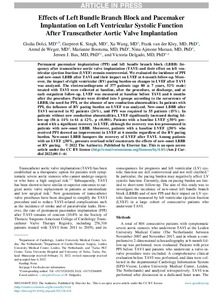Effects of Left Bundle Branch Block and Pacemaker Implantation on Left Ventricular Systolic Function After Transcatheter Aortic Valve Implantation
Dolci Giulia; Singh Gurpreet K.; Wang Xu; van der Kley Frank; de Weger Arend; Bootsma Marianne; Ajmone Marsan Nina; Bax Jeroen J.; Delgado Victoria
https://urn.fi/URN:NBN:fi-fe2022091258707
Tiivistelmä
Permanent pacemaker implantation (PPI) and left bundle branch block (LBBB) frequency after transcatheter aortic valve implantation (TAVI) and their effect on left ventricular ejection fraction (LVEF) remain controversial. We evaluated the incidence of PPI and new-onset LBBB after TAVI and their impact on LVEF at 6-month follow-up. Moreover, the impact of right ventricular (RV) pacing burden on changes in LVEF after TAVI was analyzed. The electrocardiograms of 377 patients (age 80 ± 7 years, 52% male) treated with TAVI were collected at baseline, after the procedure, at discharge, and at each outpatient follow-up. LVEF was measured at baseline before TAVI and 6 months after the procedure. Patients were divided into 3 groups according to the occurrence of LBBB, the need for PPI, or the absence of new conduction abnormalities. In patients with PPI, the influence of RV pacing burden on LVEF was analyzed. New-onset LBBB after TAVI occurred in 92 patients (24%), and PPI was required in 55 patients (15%). In patients without new conduction abnormalities, LVEF significantly increased during follow-up (56 ± 14% to 61 ± 12%, p <0.001). Patients with a baseline LVEF ≤50% presented with a significant recovery in LVEF, although the recovery was less pronounced in patients with new-onset LBBB. Moreover, patients with a baseline LVEF ≤50% who received PPI showed an improvement in LVEF at 6 months regardless of the RV pacing burden. New-onset LBBB hampers the recovery of LVEF after TAVI. Among patients with an LVEF ≤50%, pressure overload relief counteracts the effects of new-onset LBBB or RV pacing
Kokoelmat
- Rinnakkaistallenteet [27094]
